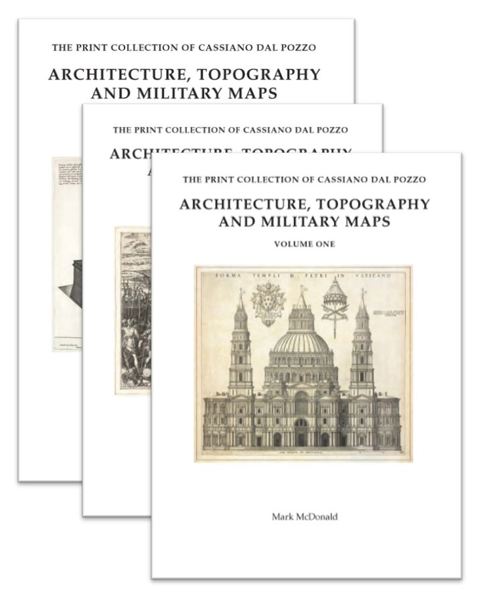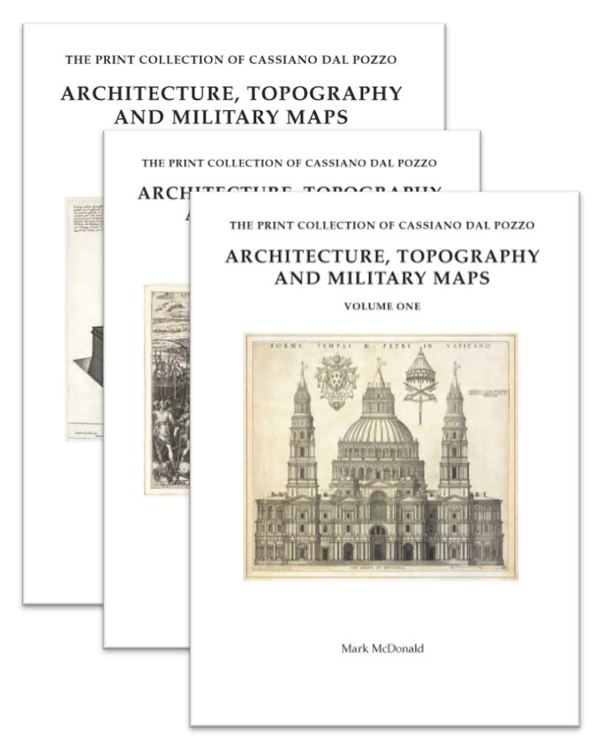
The Print Collection of Cassiano dal Pozzo. II: Architecture, Topography and Military Maps
Mark McDonald
- Pages:3 vols, xii + 901 p.
- Size:220 x 285 mm
- Illustrations:1634 b/w
- Language(s):English
- Publication Year:2019
- € 170,00 EXCL. VAT RETAIL PRICE
- ISBN: 978-1-912554-21-8
- Hardback
- Available
"(...) the clarity of layout and unexampled accuracy of editing and indexing will amaze anyone who spends time with these handsome and now indispensable volumes." (Joseph Connors, in: The Burlington Magazine, 162, May 2020, p. 460)
“In sum, architectural historians as much as print specialists will find this a priceless resource for decades to come. All the words I wanted to use in praise of this work, ‘monumental achievement’, ‘a treasure trove’, etc., have already been claimed by reviewers of the first three volumes. The best I can add is ‘hear, hear.” (Ian Campbell, in Architectural Histories, 8/1.7, 2020, p. 6)
"Other commendable qualities already present in part I and happily returning in part II include the insightful commentaries based on thorough research, an extensive, up-to-date bibliography, the elegant layout with first-rate reproductions, the meticulous editing and excellent indexes. All this contributes to making these attractive volumes a solid foundation for future scholarship." (Pieter Martens, in Print Quarterly, XXXVIII, 2021, 3, p. 317
“(…) McDonald has made an epochal contribution to early modern architectural history.” (Carolyn Yerkes, in Journal of the Society of Architectural Historians, 82/1, 2023, p. 89)
The dal Pozzo print collection was unique in its scope and organisation. Some 3,000 prints are known, in fourteen albums and many loose impressions mainly divided between the British Library and the Royal Library at Windsor Castle. Acquired from the flourishing printmaking industry of the time, the prints assembled by Cassiano dal Pozzo (1588–1657) and his younger brother Carlo Antonio (1606–89) were largely documentary and carefully ordered by subject matter: costumes, religious processions and ceremonies, tombs and catafalques, portraits, social and humorous subjects, architecture, topography, maps and military engagements.
This second and final part of the catalogue presents the architectural, topographical and military prints. Over 750 prints are devoted to ancient and modern Rome: from an album entirely dedicated to St Peter’s – the largest building project of the day – to another covering the major pilgrim and other churches in Rome, including exterior views, plans, altarpieces and statuary. The palaces and villas of Rome are also well represented, including Falda’s famous Palazzi di Roma, while the ancient city is evoked through two compilations of sixteenth-century prints: Hieronymous Cock’s Roman ruins and the Speculum Romanae Magnificentiae with many reconstructions of ancient buildings. The collection stretched well beyond Rome however, and included architecture in other Italian and European cities (including Rubens’s Palazzi di Genova and Perret’s engravings of the Escorial). The European theatre of war is represented in over 600 prints recording major sixteenth- and seventeenth-century military engagements: an extraordinary assemblage that testifies to the popularity of this genre of printmaking that not only celebrated victory but provided information to convey news of military events. This ground-breaking catalogue will be an essential resource not only for students of prints, but for all those studying European visual culture in the seventeenth century.


